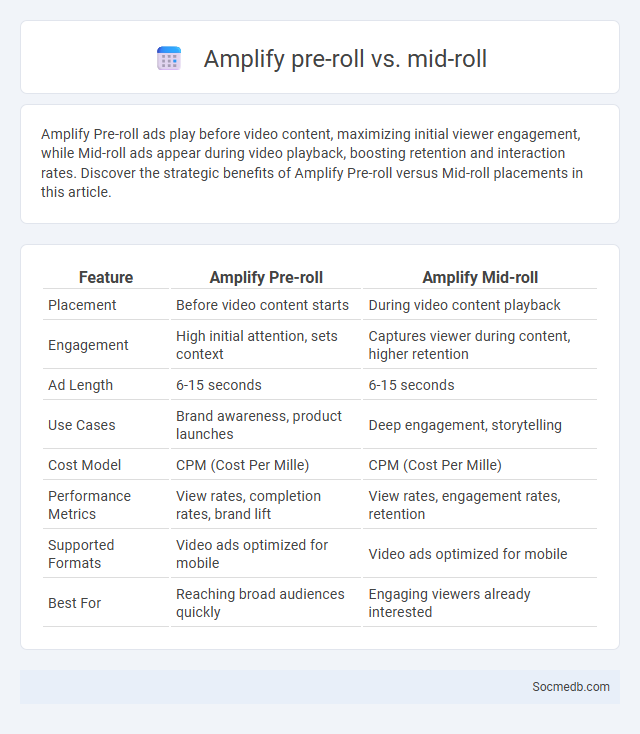
Photo illustration: Amplify Pre-roll vs Mid-roll
Amplify Pre-roll ads play before video content, maximizing initial viewer engagement, while Mid-roll ads appear during video playback, boosting retention and interaction rates. Discover the strategic benefits of Amplify Pre-roll versus Mid-roll placements in this article.
Table of Comparison
| Feature | Amplify Pre-roll | Amplify Mid-roll |
|---|---|---|
| Placement | Before video content starts | During video content playback |
| Engagement | High initial attention, sets context | Captures viewer during content, higher retention |
| Ad Length | 6-15 seconds | 6-15 seconds |
| Use Cases | Brand awareness, product launches | Deep engagement, storytelling |
| Cost Model | CPM (Cost Per Mille) | CPM (Cost Per Mille) |
| Performance Metrics | View rates, completion rates, brand lift | View rates, engagement rates, retention |
| Supported Formats | Video ads optimized for mobile | Video ads optimized for mobile |
| Best For | Reaching broad audiences quickly | Engaging viewers already interested |
Understanding Amplify Pre-roll, Mid-roll, and Amplification
Understanding Amplify Pre-roll and Mid-roll enables you to strategically place ads before or during video content, maximizing user engagement and brand visibility. Amplification boosts your social media reach by promoting content to targeted audiences, increasing impressions and potential conversions. Your social media campaigns benefit from combining these methods to enhance overall impact and drive measurable results.
What Is Pre-roll in Digital Advertising?
Pre-roll in digital advertising refers to video ads that play automatically before the main content on social media platforms or websites. These ads typically last between 5 to 30 seconds and are designed to capture audience attention quickly, leveraging high engagement rates on platforms like YouTube, Instagram, and Facebook. Advertisers use pre-roll to boost brand awareness, drive traffic, and increase conversion rates by targeting specific demographics through programmatic buying and user behavior analytics.
Exploring Mid-roll Advertising Techniques
Mid-roll advertising techniques capture audience attention by strategically placing ads during the midpoint of social media videos, increasing viewer engagement and ad recall. You can optimize performance by leveraging precise targeting, dynamic creative optimization, and seamless integration to maintain content flow without disrupting the user experience. Data-driven insights from platforms like Facebook, Instagram, and YouTube enable better placement timing and personalized messaging for maximum conversion rates.
How Amplification Enhances Video Campaigns
Amplification increases video campaign reach by leveraging social media algorithms and user sharing to boost content visibility. Paid promotions, influencer partnerships, and strategic hashtag use significantly enhance video engagement and audience targeting. This expanded exposure drives higher brand awareness, improved click-through rates, and greater conversion potential across platforms.
Key Differences: Pre-roll vs Mid-roll vs Amplification
Pre-roll ads play before your selected content, capturing immediate attention but may cause user drop-off if too long. Mid-roll ads appear during the content, often leading to higher engagement as viewers are already invested, though they can interrupt the viewing experience. Amplification boosts organic posts across social platforms, increasing reach and interaction without disrupting content flow, making it ideal for enhancing brand visibility and driving targeted traffic.
Audience Engagement: Which Format Wins?
Video content consistently drives higher audience engagement on social media platforms compared to images or text posts, with studies showing up to 1200% more shares. Interactive formats like polls, quizzes, and live streams further boost engagement by encouraging direct participation and real-time feedback. You can maximize your social media impact by prioritizing dynamic, visually rich content that invites active interaction.
Performance Metrics: Pre-roll vs Mid-roll Outcomes
Performance metrics for social media video ads reveal critical differences between pre-roll and mid-roll placements. Pre-roll ads typically achieve higher completion rates due to viewer engagement at the start, while mid-roll ads often generate better click-through rates influenced by contextual relevance. Analyzing viewer retention, brand recall, and conversion rates across platforms like Facebook, Instagram, and YouTube provides valuable insights for optimizing ad strategies.
Budget Considerations for Each Ad Format
Understanding budget considerations for each social media ad format is crucial for maximizing your marketing impact. Sponsored posts typically require moderate investment, ideal for boosting engagement, while video ads demand higher budgets due to production costs but often yield greater audience retention. Carousel and story ads generally offer flexible pricing options, enabling you to tailor spending according to campaign goals and target demographics efficiently.
Best Practices for Combining Pre-roll, Mid-roll, and Amplification
Integrating pre-roll and mid-roll ads strategically enhances viewer engagement by delivering relevant content at natural breaks, increasing ad recall and click-through rates. Leveraging amplification through targeted social media platforms boosts campaign reach and drives higher conversion by tapping into user demographics and interests. Employing data-driven optimization tools refines ad placement timing and audience targeting to maximize ROI across all ad formats.
Choosing the Right Strategy for Your Campaign
Selecting the right social media strategy involves analyzing your target audience's demographics, interests, and online behavior to tailor content that maximizes engagement and conversions. Leveraging platform-specific tools such as Instagram Stories for brand visibility or LinkedIn posts for B2B outreach enhances campaign effectiveness and reach. Consistent monitoring of key performance indicators (KPIs) like click-through rates, impressions, and follower growth ensures data-driven adjustments for optimal campaign results.
 socmedb.com
socmedb.com